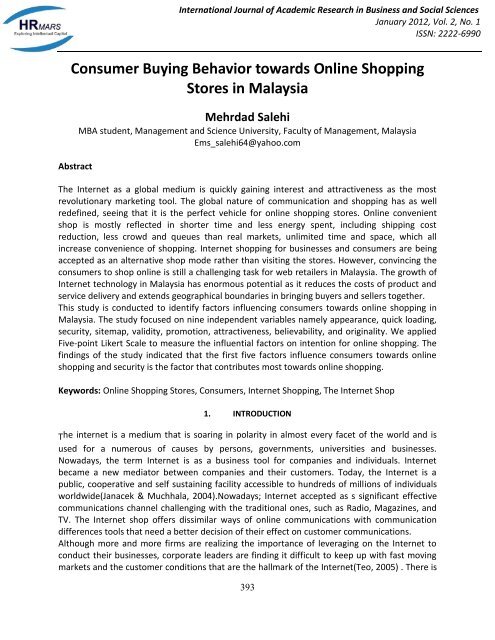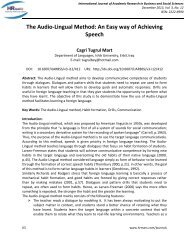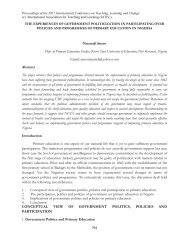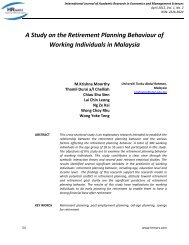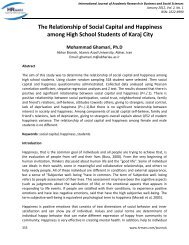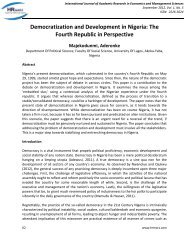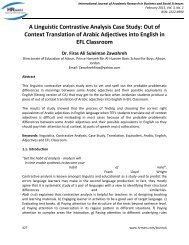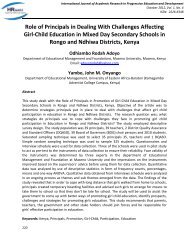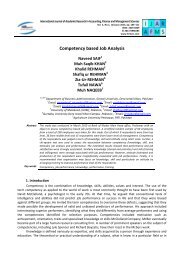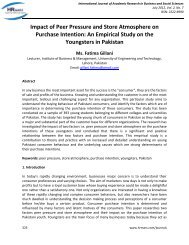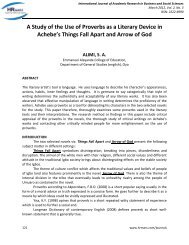Consumer Buying Behavior towards Online Shopping ... - HRMARS
Consumer Buying Behavior towards Online Shopping ... - HRMARS
Consumer Buying Behavior towards Online Shopping ... - HRMARS
- TAGS
- consumer
- hrmars
- www.hrmars.com
Create successful ePaper yourself
Turn your PDF publications into a flip-book with our unique Google optimized e-Paper software.
International Journal of Academic Research in Business and Social Sciences<br />
January 2012, Vol. 2, No. 1<br />
ISSN: 2222-6990<br />
<strong>Consumer</strong> <strong>Buying</strong> <strong>Behavior</strong> <strong>towards</strong> <strong>Online</strong> <strong>Shopping</strong><br />
Stores in Malaysia<br />
Abstract<br />
Mehrdad Salehi<br />
MBA student, Management and Science University, Faculty of Management, Malaysia<br />
Ems_salehi64@yahoo.com<br />
The Internet as a global medium is quickly gaining interest and attractiveness as the most<br />
revolutionary marketing tool. The global nature of communication and shopping has as well<br />
redefined, seeing that it is the perfect vehicle for online shopping stores. <strong>Online</strong> convenient<br />
shop is mostly reflected in shorter time and less energy spent, including shipping cost<br />
reduction, less crowd and queues than real markets, unlimited time and space, which all<br />
increase convenience of shopping. Internet shopping for businesses and consumers are being<br />
accepted as an alternative shop mode rather than visiting the stores. However, convincing the<br />
consumers to shop online is still a challenging task for web retailers in Malaysia. The growth of<br />
Internet technology in Malaysia has enormous potential as it reduces the costs of product and<br />
service delivery and extends geographical boundaries in bringing buyers and sellers together.<br />
This study is conducted to identify factors influencing consumers <strong>towards</strong> online shopping in<br />
Malaysia. The study focused on nine independent variables namely appearance, quick loading,<br />
security, sitemap, validity, promotion, attractiveness, believability, and originality. We applied<br />
Five-point Likert Scale to measure the influential factors on intention for online shopping. The<br />
findings of the study indicated that the first five factors influence consumers <strong>towards</strong> online<br />
shopping and security is the factor that contributes most <strong>towards</strong> online shopping.<br />
Keywords: <strong>Online</strong> <strong>Shopping</strong> Stores, <strong>Consumer</strong>s, Internet <strong>Shopping</strong>, The Internet Shop<br />
1. INTRODUCTION<br />
The internet is a medium that is soaring in polarity in almost every facet of the world and is<br />
used for a numerous of causes by persons, governments, universities and businesses.<br />
Nowadays, the term Internet is as a business tool for companies and individuals. Internet<br />
became a new mediator between companies and their customers. Today, the Internet is a<br />
public, cooperative and self sustaining facility accessible to hundreds of millions of individuals<br />
worldwide(Janacek & Muchhala, 2004).Nowadays; Internet accepted as s significant effective<br />
communications channel challenging with the traditional ones, such as Radio, Magazines, and<br />
TV. The Internet shop offers dissimilar ways of online communications with communication<br />
differences tools that need a better decision of their effect on customer communications.<br />
Although more and more firms are realizing the importance of leveraging on the Internet to<br />
conduct their businesses, corporate leaders are finding it difficult to keep up with fast moving<br />
markets and the customer conditions that are the hallmark of the Internet(Teo, 2005) . There is<br />
393
International Journal of Academic Research in Business and Social Sciences<br />
January 2012, Vol. 2, No. 1<br />
ISSN: 2222-6990<br />
no doubt that in the 21st century Malaysia had entered a new era of globalization. The growth<br />
of internet usage is encouraging some changes in the behavior of customer purchasing process<br />
and it has become one of the most significant communication channels in the world(CasalÃ,<br />
Flavián, & GuinalÃu, 2007).<br />
The internet apparent capabilities involve directions for collecting information, purchasing a<br />
goods, or representation a service. Internet technology advancement allows for the expansion<br />
of online shopping options beyond traditional methods, which may be more time wasting. With<br />
a growing number of individuals turning <strong>towards</strong> the Internet and the world of e-commerce to<br />
shop, enterprise, make payments, and carry out online banking, new technological<br />
advancements will have to come about to make these transactions secure. The growth of<br />
individuals are gravitating <strong>towards</strong> more exhaustive use of the Internet as technology<br />
convenience, information availability , and the capability to interact through the Internet<br />
increase and develop. <strong>Consumer</strong> behavior is the fundamental of doing each business.<br />
Moreover, businesses continue to establish an online presence, they are finding that some<br />
consumers are still reluctant to switch in that same direction.<br />
Background of study:<br />
Companies also are using the internet to express and communicate the information and<br />
actually to present their goods as well as taking feedback of their performance and get better<br />
their turnover and also customer`s satisfaction. Some companies in the world have begun to<br />
use the Internet to decrease marketing costs, and consequently reducing the prices of their<br />
goods and services to keep a competitive market in the future. The study has been assumed<br />
that people with the objective of Internet shopping used new version as individuals in all areas,<br />
more interest in using the Internet have to buy. On the other hand, the rate of innovation<br />
moderating relationship quality that people uses the online shopping and internet. It should be<br />
noted that in addition to feature a custom product aspects also be considered. In order to<br />
attract customers for the company's who following e-commerce method for their activities<br />
should be advantageous and profitable that must be also presented to the various<br />
services. Services and facilities cause the customer's motivation to purchase (in the present and<br />
future).As a result, website content services are provided on the website that should be the<br />
customer's needs and interests intended to create facilities and even provide private<br />
sectors. Although more and more firms are realizing the importance of leveraging on the<br />
Internet to conduct their businesses, corporate leaders are finding it difficult to keep up with<br />
fast moving markets and the customer conditions that are the hallmark of the Internet(Teo,<br />
2005).<br />
The growth of Internet technology in Malaysia has enormous potential as it reduces the costs of<br />
product and service delivery and extends geographical boundaries in bringing buyers and sellers<br />
together. New advanced business transactions and models for the world economy have offered<br />
by the foundation of the Internet. The advent and development of Internet has created new<br />
opportunities for marketing professional to create better present marketing practices. It also<br />
394
International Journal of Academic Research in Business and Social Sciences<br />
January 2012, Vol. 2, No. 1<br />
ISSN: 2222-6990<br />
transcends geographic boundaries, allowing companies to reach prospective customers<br />
previously unreachable.<br />
According to Nielsen Global online survey “Internet shopping Habits Globally” (2007) 1 more<br />
than half of the internets user has made at least one purchase online. In the middle of internet<br />
user's statistics, 99 % of South Korean with internet access has highest percentage of internet<br />
shopping, tracked by the UK (97 percent), Germany (97%), Japan (97%) with the U.S. eight, at<br />
94 percent. The process of purchasing services or product through internet refers <strong>Online</strong><br />
shopping behavior that this process includes five steps. <strong>Consumer</strong> recognizes their need for<br />
particular goods or services that refer to internet and seek for need-related information in this<br />
process. Moreover, goods purchasing without leaving their place is one of the great interest to<br />
many consumers and another advantage of online shopping for customer is ability of using<br />
internet tools for searching the goods or services price, then comparison with other<br />
competitors.<br />
As a result, they can enable to choose the lowest available price. Regarding to studies, online<br />
shopping has been came out quite recently as a border for transactions between consumers<br />
and firms. Internet shopping is changing the methods that customers buy goods, services, and<br />
quickly developed into a global fact and phenomenon. There is a difference among the number<br />
of consumers who visit a website and the number of real purchases being made.<br />
Problem Statement:<br />
In contrast, one of the great concerned is trust and security. For instance, recent statistics<br />
shown that in Malay people approximately is about 30% did not commit with the online<br />
shopping, while one of significant factors in electronic commerce is trust. In order to increase<br />
online shopping in Malaysia, understanding consumer online shopping behavior and factors<br />
influencing this behavior when shopping online should be given priority. Researches indicate<br />
that majority of Malaysian (76%) specially young people were using internet for non-shopping<br />
activities such as seeking for information , entertainment , playing games and communication<br />
with others. There are some barriers which have contributed to the unwillingness of Malaysian<br />
people because they afraid that their personal information will be stolen by others. Despite the<br />
potential in Malaysian people, there is still lack of understanding <strong>towards</strong> online shopping in<br />
Malaysia.<br />
Objectives of study:<br />
This research conducted to find factors influencing on consumers <strong>towards</strong> online shopping in<br />
Malaysia. Some factors such as quality website and internet marketing companies persuade<br />
consumer choice of buying online. Moreover, the study is also finding out to examine the<br />
perceptions of adopters and also those who are reluctant of online shopping in respect of<br />
demographic profile, consumers’ expectations of online stores, as well as, its exacting<br />
advantages and problems. It is worth mentioning that Internet users are adopters who have<br />
purchased online, while it is more likely that a group of people have never purchased online. In<br />
1 http://my.nielsen.com/site/20080414.shtml<br />
395
International Journal of Academic Research in Business and Social Sciences<br />
January 2012, Vol. 2, No. 1<br />
ISSN: 2222-6990<br />
the first portion, the literature review regarding consumers’ online buying behavior and the<br />
elements that encouraging or discourage online shopping is presented.<br />
Literature Review:<br />
As Internet usage is increasing, so is online shopping particularly in those countries whose<br />
marketing infrastructures are well developed. Customers can shop at anytime and have access<br />
to products not available in their geographic region. Moreover, they are now able to access the<br />
Internet, not only from their personal computers, but also from advanced electronic devices<br />
such as Palm Pilots and mobile phones. The growth of Internet technology in Malaysia has<br />
enormous potential as it reduces the costs of product and service delivery and extends<br />
geographical boundaries in bringing buyers and sellers together. Also, due to an increase in<br />
high-speed Internet access connections, lower connection costs, and increasing consumer<br />
competence, e-commerce activity will continue to grow as the availability and ease with which<br />
the Internet provides consumers the ability to handle needed tasks increasingly develops.<br />
However, not all consumers are turning to the Internet for shopping. While the number of<br />
Internet users who have made a purchase at one time is more than half in the United States,<br />
this does not explain the disparity between the number of visits websites recorded and the<br />
number of actual purchases made online.<br />
In order to identify the differences between consumers who prefer online shopping and those<br />
who prefer offline shopping, this study examines how consumers perceive online shopping and<br />
which factors are perceived differently between consumers who prefer online shopping and<br />
consumers who prefer offline (physical store) shopping. The findings from this study will allow<br />
online businesses to be better informed of what draws consumers or prohibits them from<br />
coming to their best websites. The better understand awareness of online shoppers, the higher<br />
the chance which they can create a center of attention and keep consumers.<br />
Internet Privacy and it Security issues in online <strong>Shopping</strong>:<br />
A study of risk perceptions also indicates that consumers are concerned with unwanted<br />
outcomes and uncertainty of their purchases after purchasing a product online. <strong>Consumer</strong>s,<br />
therefore, are less likely to make purchases online if they perceive a higher risk. The perception<br />
of risk associated with a company and their online presence can also be affected by previous<br />
encounters and also affect their decisions to complete purchases without sensory perceptions<br />
available in traditional brick-and-mortar stores. <strong>Consumer</strong>s’ previous experiences with online<br />
purchases, or lack thereof, can be a significant influence of levels of risk perception by<br />
consumers and their purchasing decisions. Negative experiences increase levels of risk<br />
perception with online purchasing and hamper not only a business’s likelihood of retaining<br />
customers but can make it more difficult for other online businesses to gain initial customers.<br />
Product Value:<br />
It sometimes called product understanding (product perception) (Dillon & Reif, 2004), consists<br />
of price, product quality, and variety. These are the most salient product perceptions<br />
396
International Journal of Academic Research in Business and Social Sciences<br />
January 2012, Vol. 2, No. 1<br />
ISSN: 2222-6990<br />
mentioned in the e-market literature. Price is the monetary payout of the customers and is the<br />
cost of purchasing; it is important since pricing strategy can be easily implemented over the<br />
internet. Thus, perceived quality of product can be describe as the judgment about the overall<br />
excellence or superiority of the service or goods with admiration to its proposed reason relative<br />
to alternatives (Boisvert & Burton, 2009). Since the perceived product quality is a pivotal reason<br />
to buy(Aaker, 1991) , price is the cost paid by the customers, and variety gives the customers<br />
more alternatives to choose the products and hence motivate the customers to visit the<br />
website; these three factors were empirically justified as important factors for internet<br />
shopping(Rust, Zeithaml, & Lemon, 2000). Hence, we have the following hypothesis:<br />
Hypothesis 1: Product perception affects purchase intention.<br />
Experience shopping:<br />
They deemed shopping experience could be classified into two categories. The first one is the<br />
experience from the salesperson’s encounter, and such interpersonal factors include<br />
salesperson’s efforts, interpersonal engagement, problem resolution, interpersonal distance,<br />
and sale personnel’s time commitment; the other is non-interpersonal factors which include<br />
unanticipated acquisition and value or vice versa. Additionally, Kerin, Jain, and Howard (1992)<br />
considered shopping experience as the store atmosphere, customer-related services and a set<br />
of policies. Since the two definitions of shopping experience are quite similar and<br />
complementary to each other, by combining the two definitions, shopping experience will be<br />
defined as "the set of all services and policies related to the store-atmosphere and<br />
customers, including interpersonal interaction, sales staff's efforts and commitment and<br />
relevant policies provided to please or attract customers."The shopping experience in the<br />
cyber world is quite different from conventional stores.<br />
Effort, life style compatibility, playfulness have been mentioned (Winn & Beck, 2002). Effort is<br />
the amount of time and energy spent in locating merchandise and making purchase decisions.<br />
Life style compatibility considers the consumers‟ life style and shopping habits. Playfulness<br />
refers to feelings of fun in website navigation when purchasing. Social interaction means the<br />
interaction with people when shopping on the web, such as joining discussion groups, soliciting<br />
user experiences etc.<br />
Hypothesis 2: The shopping experience affects purchase intention.<br />
Service Quality:<br />
We may call service in question as “supporting service” which accompanies the main<br />
product/service and facilitates the purchasing process. The concept of service quality whether<br />
the quality meets or exceeds the consumer’s expectation; therefore, the consumer’s perception<br />
of service quality is the perceived gap after comparing the consumer’s expectations of service<br />
and the actual feeling of the service (Sultan & Simpson Jr, 2000).While the consumer’s<br />
expectation of service quality is often affected by the influence of four sources: past<br />
experience, word-of-mouth communication, personal needs and external communication,<br />
service quality is a subjective attitudinal response showing the consumer’s overall superiority<br />
assessment of the service itself. A direct measurement of consumers‟ service quality called<br />
397
International Journal of Academic Research in Business and Social Sciences<br />
January 2012, Vol. 2, No. 1<br />
ISSN: 2222-6990<br />
SERVPERF was proposed by (Jain & Gupta, 2004) and was shown to have better predictive<br />
ability, convergent validity, and discriminant validity than SERVQUAL.<br />
For online shopping, e-service quality was measured by different researchers. According to(Park<br />
& Gretzel, 2007), Parasuraman, Zeithaml, and Malhotra (2005) suggested efficiency, system<br />
availability, fulfillment, and privacy as the major factors to be considered. Therefore, the<br />
following hypothesis is suggested:<br />
Hypothesis 3: Service quality affects purchase intention.<br />
Research Methodology<br />
Study design:<br />
This study is based on hypothesis testing regarding the fact that data were collected only once<br />
to answer to research questions through questionnaire in Malaysia, concerning the fact of<br />
customer perceptions toward online shopping.<br />
Main objective:<br />
� To understand correlation between website quality and online shopping behavior.<br />
� To understand correlation between advertising and online shopping behavior.<br />
Sources and Data Collection:<br />
A prearranged survey was used to gather the primary data research to respond the questions of<br />
survey. Therefore, the survey questions consist two specific sections in addition to demographic<br />
part and each of them contains questions to reflect different parts of the study. The Budget<br />
constraints in terms of time and cost and difficulty to access to the potential respondents in<br />
Malaysia lead us to use the convenience sampling method. Therefore, some specific places<br />
inside were chosen for distributing the questionnaires. For instance some places like SURIA<br />
KLCC, CAPSQUERE, and PAVILLION were chosen for separating questionnaire. The survey was<br />
conducted generally via face-to-face interview and also hands over the questionnaire.<br />
Before we chosen face to face interview we sent the questionnaire through email to more than<br />
75 people but unfortunately only 15 people replied in one week. Then we switch our data<br />
collecting method and we refer to personal interview. Therefore, the survey responses<br />
provided us with the valuable inputs to this study for better understanding the online shopping<br />
practices in Malaysia. Total 75 questionnaires were distributed; while each of answers<br />
submitted was monitored correctly for mistake, unfinished and/or omitted responses. Though,<br />
10% of the questions in the analysis survey that had been left unanswered or wrongly answered<br />
were subtracted from functional data analysis. Having done the appropriate screening process,<br />
returned questionnaires were considered as unusable and the rest 60 responses were used<br />
which were measured as total and valid for last analysis and hypothesis testing.<br />
398
Measures:<br />
International Journal of Academic Research in Business and Social Sciences<br />
January 2012, Vol. 2, No. 1<br />
ISSN: 2222-6990<br />
We used questionnaire as an instrument to obtain required data for analysis of the hypothesis<br />
we developed. In this study we used 1- LIKERT scale and In Likert scale anchored from “strongly<br />
disagree” (1) to “strongly agree” (5) to measure relation between website quality and online<br />
shopping behavior and also correlation between advertising and online purchasing.<br />
Hypothesis development:<br />
From the discussion of the theoretical framework, two hypotheses were prepared to<br />
assessment the relationship between each of the two independent variables and dependent<br />
variable. The two hypotheses which this study has been conducted on it are:<br />
H1: High quality website positively associated with the online shopping<br />
H2: Advertisement positively associated with the intention to online shopping.<br />
Below are analyses of demographic data: 1- gender, 2- age, 3- marital status, 4- monthly<br />
income, 5- occupation, 6- educational background, 7- internet using duration, 8- online visiting<br />
website.<br />
As it obvious in this pie 46.67% of respondent were female and 53.33% were male.<br />
RESULTS AND DISCUSSION:<br />
Factor Analysis:<br />
The following table at the beginning provides some descriptive analysis regarding to<br />
demographic information. Following the conducting the factor analysis on all the items that<br />
measures ordinal variable, 9 variables extracted, each one representing a unique concept or in<br />
other word a specific perception of the respondents. Following table illustrate the mean for<br />
each item and corresponding standard of deviation. The first 5 items measure quality<br />
effectiveness of websites and the last 4 items measures advertising effectiveness toward using<br />
online shopping.<br />
But because our scale for our main question is base of the likert scale we have to use the factor<br />
analysis. In this project factor analysis was employed to explore the underlying factors<br />
associated with 9 items by using Principal Component Analysis (PCA). Generally, KMO is used to<br />
assess which variables need to drop from the model due to multi Collinearity. The value of KMO<br />
varies from 0 to 1, and KMO overall should be .60 or higher to perform factor analysis. If not<br />
then it is necessary to drop the variables with lowest anti image value until KMO overall rise<br />
above .60. Result for the Bartlett’s Test of Sphericity and the KMO reveal that both were highly<br />
significant and concluded that this variable was suitable for the factor analysis.<br />
It can be seen the KMO is more than 0.6 is acceptable and it’s in mediocre range, it means no<br />
need for drop any variables, besides P-value is less than 0.001, means we can proceed with<br />
factor analysis.<br />
Besides, the correlation of the items are between 0.3 to 0.9 which means all the items<br />
correlation is acceptable, in this case there is no duplication, and all have a association.<br />
Moreover, we grouped the questions regarding to every hypothesis and again make a<br />
correlation between them and dependent factor, it can be seen although there is a good<br />
correlation between website quality and advertising and website quality and intention to online<br />
shopping, but poor correlation between advertising and dependent factor is transparent. Factor<br />
399
International Journal of Academic Research in Business and Social Sciences<br />
January 2012, Vol. 2, No. 1<br />
ISSN: 2222-6990<br />
analysis was carried out on the effective factor on online shipping to group together the<br />
variables that are highly correlated. The factor analysis process involves two stages:<br />
1- Factor withdrawal to make a preliminary decision on the number of factors fundamental<br />
asset of calculated variables of interest.<br />
2- Factor rotation for easy interpretability of factor withdrawal result and for making final<br />
decision about the underlying factors. The underlying structure of 9 items was analyzed<br />
using principal component analysis followed by varimax rotation because we have an<br />
independent variable. The factor analyses exposed two dimensions underlying effectual<br />
factor on online shopping for Malaysian customers.<br />
They are: (F1), High Quality websites (F2), Advertising. The total variance explained by factors is<br />
indicated in Table, which suggests that the two factors account for 74% of the total variance.<br />
Factor 1, which accounted for about 61% of total variance. In fact, each of above component<br />
represents a factor that explains the total variances in all the 8 original items as listed above. As<br />
shown in the Table.2, the Eigen values for just the two components are above the value 1, thus<br />
they are to be considered significant. It can be seen in the Table 2, each of these components<br />
explains 61.376 %, 12.810%, of the total variance respectively, among the all 9 items.<br />
It has been illustrated in Figure 1, There is a dramatic steep slope from component 1 to<br />
component 2, hence most of the variance is explained by factor 1 alone and small portion by<br />
component 2 and then again there is a steep slope to component 3, Whereas, the slop of the<br />
diagram change gently from component 4 to component 9 which again indicate that most of<br />
variance is explained by the first 2 components and subsequent factor do not contribute much<br />
in explained variance. Now, we founded that we have a two factor, so the question now is each<br />
item is regarding to which factor, for this we look at the component matrix table.<br />
Factor Loading<br />
Rotated Component Matrix a<br />
Component Cronbach’<br />
s<br />
1 2 alpha<br />
Appearance .704<br />
Quick<br />
Loading<br />
.653<br />
Security .829 0.801<br />
Sitemap .596<br />
Validity .828<br />
Promotion .774<br />
Attractivenes<br />
s<br />
.514<br />
Believability .798 0.721<br />
Originality .750<br />
All the Cronbach’s alpha value for components is well above value of 0.721 which indicate to<br />
good level of internal consistency. Seemingly, component 1 represents five first variances in the<br />
400
International Journal of Academic Research in Business and Social Sciences<br />
January 2012, Vol. 2, No. 1<br />
ISSN: 2222-6990<br />
five first items in the questionnaire and it is designated as Security effectiveness. Moreover, the<br />
other components are designated as Believability effectiveness.<br />
Hypothesis testing:<br />
Due to measuring the concept based on a five points Likert Scale which gives ordinal data, this<br />
study has been manipulated the Factor Scores to analyze hypotheses.<br />
H1: High quality (Secure) website positively associated with the online shopping<br />
Base of the Pearson correlation test, the r value between Security (high quality) and intention<br />
to buy is 0.418, which is more than 0.3, so there is a significant association between high quality<br />
(Secure) website and intention for online shopping. And p-value is less than 0.05, therefore the<br />
H1 is accepted.<br />
H2: Advertisement (believability of ads) positively associated with the intention to online<br />
shopping.<br />
The Pearson Correlation test applied to test the significance and direction of relationship.<br />
Results are illustrated in following table.<br />
Correlations<br />
Believabilit<br />
y<br />
Intention<br />
to online<br />
_shopping<br />
Believabil<br />
ity<br />
Pearson<br />
Correlation<br />
1 .073<br />
Sig.<br />
tailed)(2-<br />
.579<br />
N 60 60<br />
Pearson<br />
Correlation<br />
Sig. (2tailed)<br />
.073 1<br />
.579<br />
N 60 60<br />
Intention<br />
to online<br />
_shopping<br />
Having considered above table, The Pearson Correlation Coefficient value equals to 0.073 which<br />
is lower than 0.3 indicating there is any neither positive nor negative association between<br />
Advertisement (believability of ads) and intention to online shopping. Thus, the hypothesis H2<br />
is rejected.<br />
Conclusion<br />
Our study revealed the last four factors (promotion, attractiveness, believability, and<br />
originality) don’t significantly influence online shopping intention. These indicate that<br />
401
International Journal of Academic Research in Business and Social Sciences<br />
January 2012, Vol. 2, No. 1<br />
ISSN: 2222-6990<br />
advertisement doesn’t have an important effect on online shopping. The results showed that<br />
security and validity of website were widely approved by online consumers. Attractiveness had<br />
the minimum influence on online shopping intention. This shows that consumers aren’t<br />
interested or couldn’t believe any advertisement in the internet. It seems that the internet<br />
users are overloaded by advertisement spams.<br />
References:<br />
Aaker, D. A. (1991). Managing brand equity: Capitalizing on the value of a brand name: Free Pr.<br />
Bei, L. T., & Chiao, Y. C. (2001). An integrated model for the effects of perceived product,<br />
perceived service quality, and perceived price fairness on consumer satisfaction and<br />
loyalty. Journal of <strong>Consumer</strong> Satisfaction Dissatisfaction and Complaining <strong>Behavior</strong>, 14,<br />
125-140.<br />
Boisvert, J., & Burton, S. (2009). The impact of perceived innovativeness, branding strategy and<br />
parent brand salience on the reciprocal transfer of core associations. International<br />
Journal of Business Excellence, 2(3), 346-359.<br />
CasalÃ, L., Flavián, C., & GuinalÃu, M. (2007). The impact of participation in virtual brand<br />
communities on consumer trust and loyalty: The case of free software. <strong>Online</strong><br />
Information Review, 31(6), 775-792.<br />
Dillon, T. W. D. T. W., & Reif, H. L. R. H. L. (2004). Factors Influencing <strong>Consumer</strong>s€ Factors<br />
Influencing <strong>Consumer</strong>s€ E-Commerce Commodity Purchases Commerce Commodity<br />
Purchases. Information Technology, Learning, and Performance Journal, 22(2), 1.<br />
Jain, S. K., & Gupta, G. (2004). Measuring service quality: SERVQUAL vs. SERVPERF scales.<br />
Vikalpa, 29(2), 25-37.<br />
Janacek, R., & Muchhala, M. (2004). Method of transferring data from a sender to a recipient<br />
during which a unique account for the recipient is automatically created if the account<br />
does not previously exist: Google Patents.<br />
Park, Y. A., & Gretzel, U. (2007). Success factors for destination marketing web sites: a<br />
qualitative meta-analysis. Journal of Travel Research, 46(1), 46-63.<br />
Rust, R. T., Zeithaml, V. A., & Lemon, K. N. (2000). Driving customer equity: How customer<br />
lifetime value is reshaping corporate strategy: Free Pr.<br />
Sultan, F., & Simpson Jr, M. C. (2000). International service variants: airline passenger<br />
expectations and perceptions of service quality. Journal of Services Marketing, 14(3),<br />
188-216.<br />
Teo, T. S. H. (2005). Usage and effectiveness of online marketing tools among Business-to-<br />
<strong>Consumer</strong> (B2C) firms in Singapore. International journal of information management,<br />
25(3), 203-213.<br />
Winn, W., & Beck, K. (2002). The persuasive power of design elements on an e-commerce web<br />
site. Technical Communication, 49(1), 17-35.<br />
402
Sciences<br />
International Journal of Academic Research in Business and Social<br />
403<br />
January 2012, Vol. 2, No. 1<br />
ISSN: 2222-6990


